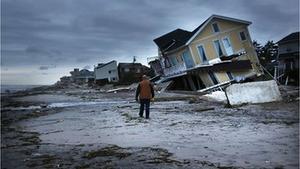DisastersU.S. suffered $119 billion in disaster-related losses in 2012
Natural and man-made disasters contributed to $186 billion in economic losses around the world last year. The United States took the biggest hit with $119 billion in losses. Insurance claims for weather-related losses in 2012 totaled $77 billion dollars, the third most expensive losses on record. Nine of the top ten most expensive insured loss events which occurred last year happened in the United States.

Hurricane Sandy cut a wide swath of incomprehensible damage // Source: noyon.mn
Natural and man-made disasters contributed to $186 billion in economic losses around the world last year, and led to 14,000 deaths, according to a study by the global insurer Swiss Re.
The United States took the biggest hit with $119 billion in losses. Of these losses, public and private insurers paid for more than half of the damage. Insurance Journal reports that Insurance claims for weather-related losses in 2012 totaled $77 billion dollars, the third most expensive losses on record.
In addition, nine of the top ten most expensive insured loss events which occurred last year happened in the United States.
“The severe weather-related events in the U.S. provided a reminder of the value of insurance and the vital role it plays in helping individuals, communities and businesses to recover from the devastating effects of catastrophes,” Kurt Karl, Swiss Re’s chief economist told the Insurance journal. “However, large parts of the globe that are prone to weather extremes were not able to rely on financial relief due to low insurance penetration.”
Record heat also contributed to one of the longest droughts in decades, which affected more than half the country. Crop failures in the U.S. Corn Belt caused agricultural losses of $11 billion, including pay-outs from the federal Multi-Peril Crop Insurance (MPCI) assistance program, making this the highest recorded loss in agricultural insurance history.
“The record drought in the bread basket of the U.S. highlighted the economic importance of insurance, supporting the economic survival of thousands of farmers,” the report states.
Hurricane Sandy caused an estimated $70 billion in economic and insured losses. Insures losses were an estimated at $35 billion, and between $20 and $25 billion were covered by the private insurance market. The rest was covered by the National Flood Insurance Program (NFIP).
The losses from Hurricane Sandy were due to the largest wind span recorded for a North Atlantic hurricane. In addition to serious flooding across the east coast, the hurricane also inflicted the worst power outage caused by a natural disaster in the history of the United States. Sandy also hit sections of Canada and the Caribbean.
“Sandy challenged the industry with its combination of record wind field and storm surge,” Matthias Weber, Swiss Re’s Group chief underwriting officer told the Insurance Journal. “The possibility that such events could increase in frequency and strike densely populated regions such as the northeast U.S. means that extreme storm-surges need to be more thoroughly understood.”
A simulation exercise presented in Swiss Re’s sigma study shows that an increase of sea levels of ten inches by the year 2050 will nearly double the amount of flood losses, which would mean a $20 billion insured loss event.
